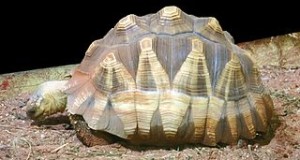Remote-sensing infrared thermometers, or “temperature guns”, have revolutionized reptile and amphibian husbandry. I first used them at the Bronx Zoo, and was instantly hooked. I was under the impression that my experience in herp care had left me with a good “feel” for exhibit temperatures, and the standard thermometers I used confirmed this. That belief was shattered by infrared thermometers, which provide an instant digital read-out when pointed at an animal, surface, or the air.
In several cases, I was able to make major environmental improvements that fostered better health and breeding. Early models were unwieldy, but inexpensive, pocket-sized units are now available to pet-owners. I consider infrared thermometers to be an indispensable piece of equipment for both seasoned keepers and novices alike. My favorite is the Zoo Med ReptiTemp Digital Infrared Thermometer.
 Avoiding “Beginner’s Mistakes”
Avoiding “Beginner’s Mistakes”
The Zoo Med ReptiTemp Digital Infrared Thermometer allows newcomers to our hobby to start-off on a somewhat more advanced level than was possible in days past. By simplifying the process of recording temperatures, this thermometer encourages us to look more deeply into the needs of our pets. The time and effort involved in setting up healthful thermal gradients and naturalistic basking, hibernation, incubation, and nesting sites is greatly reduced.
Temperatures can be instantly checked via the point-and-shoot function, or the device can be set to continually monitor temperatures over a 1 hour period.
Temperature Gradients
I value infrared thermometers for many reasons, but chief among these is the ease with which I can establish thermal gradients. Thermal gradients, critical to good health, allow ectothermic (“cold-blooded”) creatures to regulate their body temperatures by moving between hot and cooler areas. Many health and breeding successes and failures are attributable to the presence or lack of a proper thermal gradient.
Zoo Med’s ReptiTemp Digital Infrared Thermometer has a “Min-Max Function” that allows us to see how temperatures change within the terrarium. The device can also be set to measure the ambient (average background) temperature as well, thus providing a complete picture of the thermal gradient in your pet’s enclosure.
Monitoring Basking and Body Temperatures
An animal’s surface temperature can also be quickly determined (remotely, without the need for handling). This has provided me with a great deal of valuable information…in fact, I went crazy with my first temperature gun, even measuring animals in their natural habitats. Interesting surprises awaited – for example, I found that Red-Eared Sliders basking on a cool March day in NYC were able to raise their temperatures by at least 20 F above that of the air. Creating suitable basking areas for my pets and exhibit animals suddenly became much simpler. I also began using temperature guns in all of my fieldwork.
Hide Boxes and Shelters
Another important application for the ReptiTemp is in the placement of hide boxes. Many creatures will choose security over appropriate temperatures…shy individuals may, therefore, spend too much time in hide-spots that are too cool or too hot. Once we determine the range of temperatures in an enclosure, we can easily place one or more shelters in those locations where out pets’ temperature needs will be best served.
Heat Pads
Important temperature measurements that are often overlooked can be easily monitored with the ReptiTemp. For example heat pads mounted beneath terrariums can provide a warm (or too-warm) resting spot, but often fail to raise the temperature of the surrounding air. Both surface and air temperatures should be checked regularly, especially at night, as your pets can become ill if they inhale overly-cool air, even when resting above a heat pad.
 That Reptile Blog – Reptile, Amphibian and Exotic Pet Care and Information
That Reptile Blog – Reptile, Amphibian and Exotic Pet Care and Information






Do you have any recommendations for a UV light reader? Thanks!
Hi Lex,
I’m not up on the latest models, etc…SolarTech comes to mind; I believe we used their early models at the zoo with good results. Best, Frank